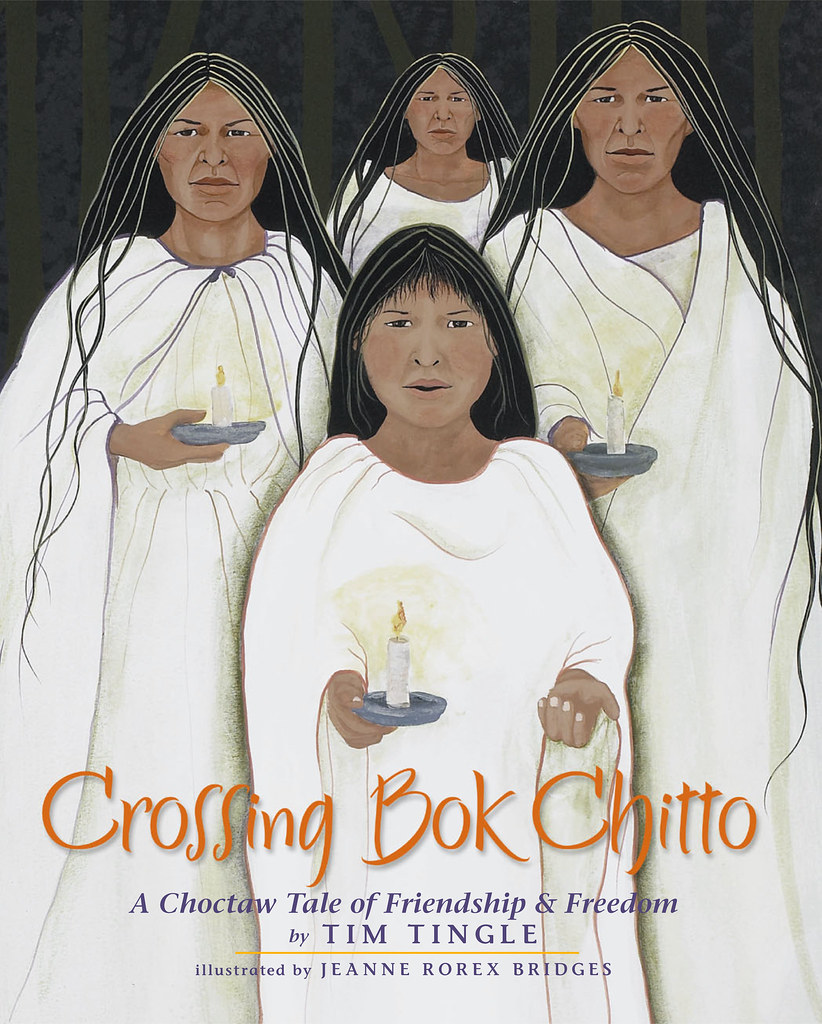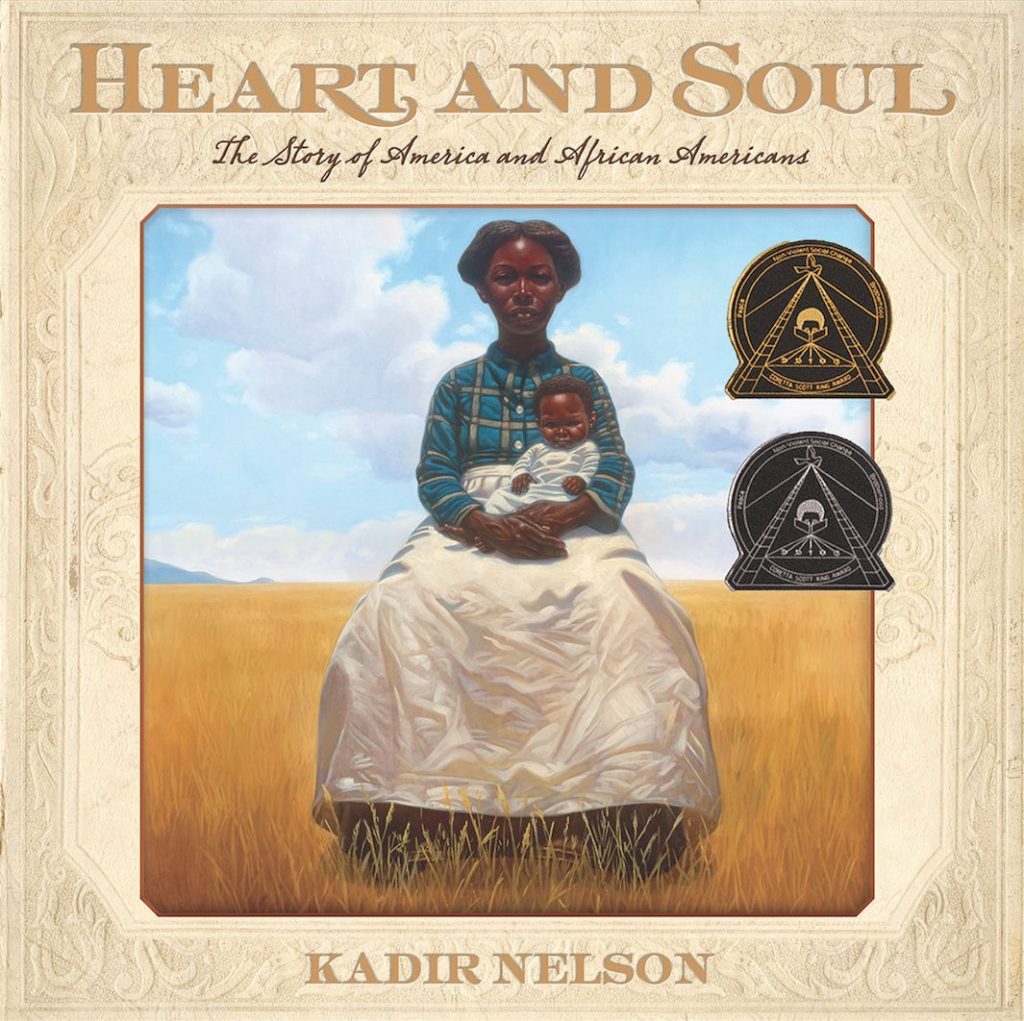
1. Bibliography
Tingle, Tim, and Jeanne Rorex Bridges (illustrator). 2006. Crossing Bok Chitto: A Choctaw Tale of Friendship & Freedom. El Paso: Cinco Puntos Press. ISBN 9780938317777
2. Plot Summary
Bok Chitto is the river boundary between the Choctaw Nation and the Black slaves that work the plantation on the other side. Martha Tom’s mother warns her never to cross the river, but when the young Choctaw girl is tasked with gathering blackberries for a wedding, she sees delicious bushes on the other side and can’t help but cross. When Martha Tom gets lost, members of a forbidden slave church help her, sending one young Black slave, Little Mo, to direct her back across the river. Soon, a friendship blooms between Martha Tom and Little Mo. When Little Mo’s mother learns she’s going to be sold away from her family, Little Mo asks Martha Tom’s family for help. Even though slave owners are searching for Little Mo’s mother, the combined faith of Little Mo’s and Martha Tom’s family helps Mo and his clan to literally disappear from sight. The family crosses Bok Chitto to safety and to freedom. End notes include information on the Mississippi Choctaws and on Choctaw storytelling.
3. Critical Analysis
Crossing Bok Chitto is an original story like nothing I’ve ever read before, and there’s no doubt that Tim Tingle has written an engaging story that will rivet young audiences. Children will await the turn of the page, wondering about the fates of Martha Tom, Little Mo, and their entire families. The book is also a shining example of one that manages to respect for the religious beliefs of both cultures portrayed. Little Mo and his family attend a church where the preacher preaches and the congregants sing, while Martha Tom’s family participates in the dances and chants of a Native wedding ceremony. It is both the Christian faith of Little Mo’s family and the ceremonial unity of the Choctaw Nation that bring Little Mo’s family safely across the river. Rather than allow their cultural differences to create a rift, the relationships between the Choctaw and the African Americans in Crossing Bok Chitto are positive and uplifting. As Tim Tingle writes, the story is also “documented the Indian way, told and retold and then passed on by uncles and grandmothers.” Crossing Bok Chitto has the read-aloud quality of a Native American oral tale, perfect for performing, and the fact that the entire story has stemmed from a conversation with Archie Mingo, one of Tingle’s trible elders, adds to its authenticity. The Choctaw chant in the story, a real wedding chant, is another valuable addition.
Bridges’s illustrations are also, for the most part, a plus. Her illustrations accurately depict the characters on both sides of the river—Martha Tom and the Choctaw people look much different from Little Mo and the African American slaves, both in physical characteristics and in dress. Unfortunately, while the illustrations are accurate and each character is drawn distinctly rather than stereotyped, the art style, a mix of acrylic and watercolor painting, feels slightly dated.
Still, while the front cover may not immediately draw children in, the storyline will. Parents, teachers, and other caregivers should make the effort to introduce their children to this unique book, crossing cultural divides and telling a story that isn’t often told. Recommended for all picture book shelves.
4. Rewards and Review Excerpts
Booklist Book Review Stars, 2006
Publishers Weekly Book Review Stars, 2006
American Indian Youth Literature Award, 2008, Winner
Jane Addams Children’s Book Award, 2007, Honor
Skipping Stones Honor Award, 2007
ALSC Notable Children’s Book, 2007
From Children’s Literature: “Tom Tingle, a member of the Choctaw Nation of Oklahoma, tells a very moving story about friends helping each other and reveals a lesser-known part of American History: Native Americans helped runaway slaves. . . . While this is a picture book, it would make a wonderful read-aloud for middle elementary students.”
From Booklist: “In a picture book that highlights rarely discussed intersections between Native Americans in the South and African Americans in bondage, a noted Choctaw storyteller and Cherokee artist join forces with stirring results.”
5. Connections
Create a display of Crossing Bok Chitto and other books by Tim Tingle, such as the following selections:
- How I Became a Ghost: A Choctaw Trail of Tears Story. ISBN 9781937054533
- Saltypie: A Choctaw Journey from Darkness into Light. ISBN 9781933693675
- Stone River Crossing. ISBN 9781620148235
- Danny Blackgoat, Navajo Prisoner. ISBN 9781939053039
- House of Purple Cedar. ISBN 9781935955696
Create a display of Crossing Bok Chitto and other freedom-themed picture book stories, such as the following selections:
- Shange, Ntozake. Freedom’s a-Callin’ Me. ISBN 9780061337413
- Weatherford, Carole Boston. Box: Henry Brown Mails Himself to Freedom. ISBN 9780763691561
- Lendler, Ian. The Fabled Life of Aesop: The Extraordinary Journey and Collected Tales of the World’s Greatest Storyteller. ISBN 9781328585523
- Cline-Ransom, Lesa. Overground Railroad. ISBN 9780823438730
- Sís, Peter. Nicky & Vera: A Quiet Hero of the Holocaust and the Children He Rescued. ISBN 9781324015741
- Văn, Mượn Thị. Wishes. ISBN 9781338305890
*Note—This book review was created as an assignment for a course at Texas Woman’s University.
